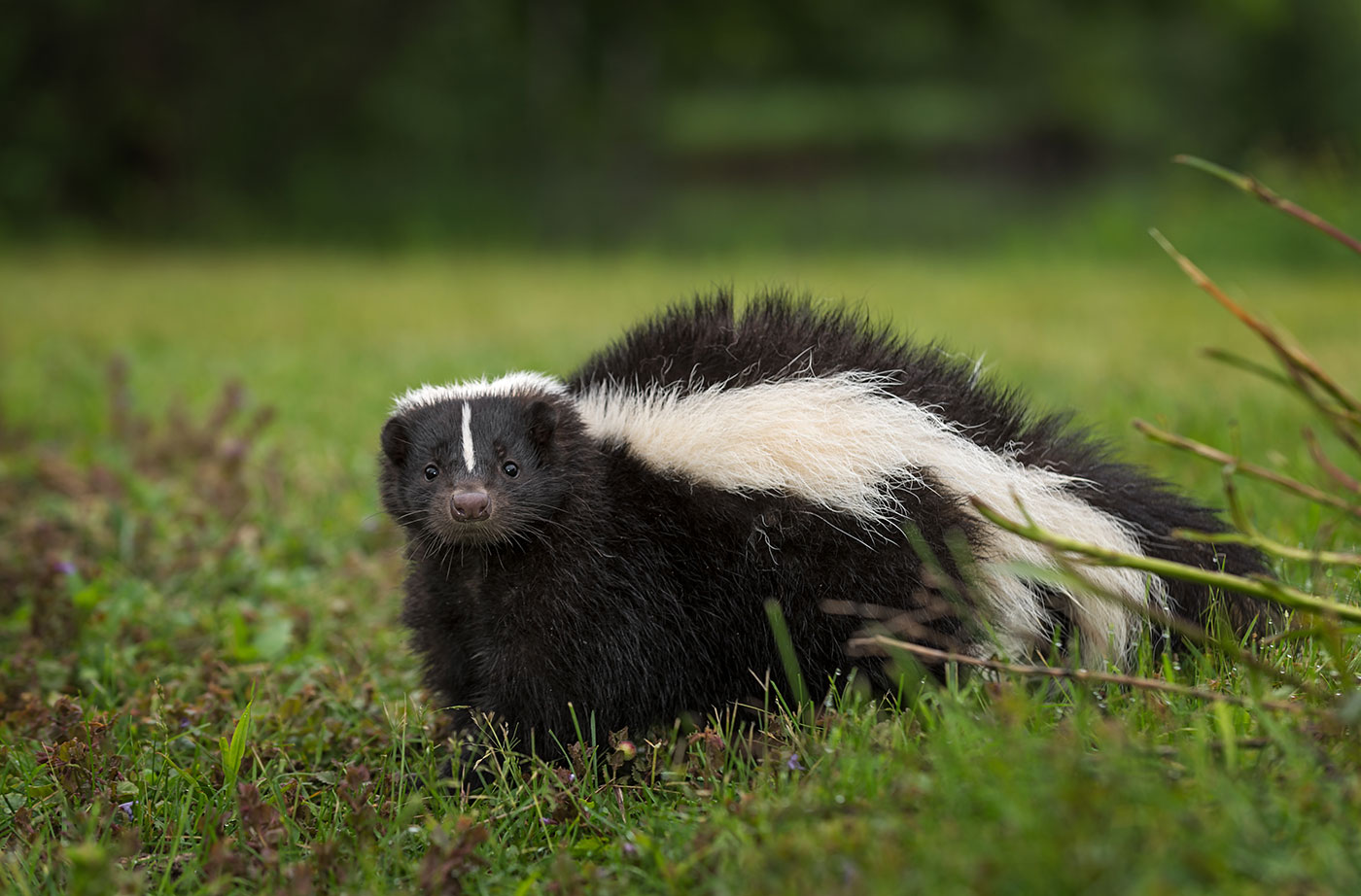 Striped Skunk
Striped Skunk
Mephitus mephitus
Cool fact: Skunks are active year-round, but during the cold of winter they slow down and stay inside their dens, which are insulated with leaves and grass, sometimes with other skunk families and friends.
The striped skunk, Mephitus mephitus, occurs throughout most of Maine, from open fields and farms to city streets and suburban backyards, and the brushy boundaries in between. They like to be near water. During the day, skunks are usually in their dens, either holes they’ve dug themselves or some other animal’s deserted burrow, in hollow trees, or under the shed.
Skunks are active year-round, but during the cold of winter they slow down and stay inside their dens, which are insulated with leaves and grass, sometimes with other skunk families and friends. In March they begin leaving their winter dens to find a mate. Kits are born in late April or early May.
A Wabanaki tale describes how the skunk got its stripes and its stink:
Skunk, who was covered with creamy white fur, decided to play a trick on the animal people. He went to see the eagle. As long as the eagle held his wings up it was daylight, when he folded them it was dark across the whole world. Skunk took a piece of string from Gluskabe’s wigwam and tied one of the eagle’s wings. That day half of the world was dark, the other half light. Because Skunk tied the wing so tightly, no one, not even Gluskabe, has been able to untie it. For this trick Gluskabe emptied the black ashes from his pipe onto Skunk and sent him down to dwell with the animal people again. As Skunk walked through the grass, the grass became evil-smelling. But Gluskabe breathed on the grass and it became sweet-smelling. Since that time Skunk must hide in the daytime and is seen about at night. The animal people do not consort with him or live very near him because he is evil-smelling. And the grass through which Skunk has walked is not eaten by any of the animal people. But Gluskabe sweetened the odor and it became sweet-grass.
When the young skunks are about two months old, they follow their mother out of the den at nightfall and through the grass to find food.
Their diet is omnivorous: small rodents, birds, eggs, insects, frogs, snakes, fruit, nuts, anything they can dig up with their claws. They will snuffle grubs and crops out of the garden, eat bird seed, and tear into the trash. Skunks like to get to the bottom of things. There are at least two cases of a Maine police officer helping a skunk that got its head stuck in a cup. (Neither cop was sprayed.) A skunk “jabs her wedge-head in a cup of sour cream” in Robert Lowell’s poem “Skunk Hour,” set on the Blue Hill Peninsula.
By late summer, the yearling skunks are almost full-grown and becoming independent. Some begin roaming to new territory. These young skunks are most responsible for the animal’s notorious odor, since according to multiple sources an “inexperienced” skunk is more likely to spray. However, it is not clear how to tell the experience level of a skunk from a distance.
Mostly, unfortunately, the human-skunk relationship is one of inconvenience, a skunk surprising the family dog or the speeding car in the middle of the night. If the opportunity arises, people do like to watch skunks. They walk funny, their fur is that striking black-and-white, teased out like an ‘80s rock star. Skunks are cute. Skunks (experienced skunks, anyway) will ignore people who encounter them (and they can’t see very well), then give a warning (a hiss and a stomp) if they feel threatened by noise or movement, raising their tail and spraying if disturbed or attacked. They reportedly are repelled by whistling and mothballs.
Only skunks use their musk for defense. Other canids, like otters, weasels, raccoons, foxes, and dogs, use it in small and subtle quantities, to mark territory or attract mates.
And so skunks have lent their name to the similarly pungent skunk cabbage, skunk spruce, skunk weed, stale beer, and a crushing cribbage loss.
Skunks will always be a source of fear, humor, and curiosity. Most humans seem to accept that skunks are not malicious or predatory with their spray, respecting or even empathizing with an animal vilified for an evolved and inherited trait that helps it survive in the world. For many people in Maine, the smell of a skunk is the smell of spring, summer, home.
Science writer Catherine Schmitt now writes about birds for Schoodic Institute at Acadia National Park. She has written many Creature Features for the Natural Resources Council of Maine. For more of her writings, visit her website at catherineschmitt.com.









